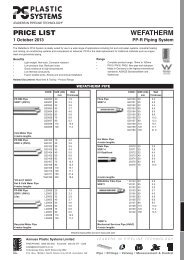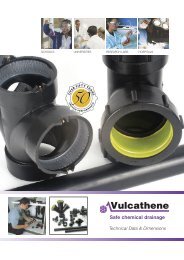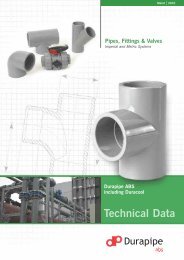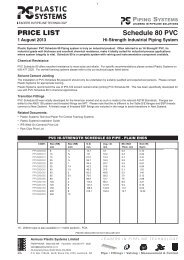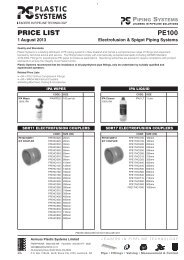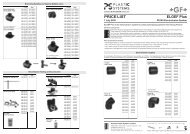Guide to Solvent Cementing PVC and CPVC Plastic ... - Glynwed Asia
Guide to Solvent Cementing PVC and CPVC Plastic ... - Glynwed Asia
Guide to Solvent Cementing PVC and CPVC Plastic ... - Glynwed Asia
Create successful ePaper yourself
Turn your PDF publications into a flip-book with our unique Google optimized e-Paper software.
11<br />
you must be able <strong>to</strong> fully bot<strong>to</strong>m the pipe in the socket during<br />
assembly. If the pipe <strong>and</strong> fittings are not out of round, a satisfac<strong>to</strong>ry<br />
joint can be made if there is a “net” fit, that is, the pipe bot<strong>to</strong>ms in<br />
the fitting socket with no interference, but without slop. A quick, dry<br />
fit “slop” test: Hold a short length of pipe vertically with a fitting<br />
“bot<strong>to</strong>med” on the pipe. If the fitting falls off the end of the pipe,<br />
do not start assembly. Contact your pipe or fitting supplier. (A good<br />
interference fit is desired for a one-step application.) Measure the<br />
fitting socket length <strong>and</strong> mark this distance on the pipe O.D. <strong>to</strong><br />
insure the fitting had been fully inserted, add a couple inches <strong>to</strong> this<br />
distance <strong>and</strong> make a second check mark on the pipe, as the primer<br />
<strong>and</strong> cement will remove the first mark. All pipe <strong>and</strong> fittings must<br />
conform <strong>to</strong> ASTM or other recognized product st<strong>and</strong>ards.<br />
8. Check for penetration <strong>and</strong> softening of the pipe’s surface. Take<br />
a scrap piece of the pipe you will be using <strong>and</strong> make a normal<br />
application of the cement. Then immediately, using a knife or other<br />
sharp object, try <strong>to</strong> scratch or scrape a few thous<strong>and</strong>ths of the<br />
surface away. If you are able <strong>to</strong> do so, proceed with installation. If<br />
not, try making a more aggressive application of the cement on the<br />
scrap piece of pipe <strong>and</strong> check for penetrations noted above. If you<br />
still are unable <strong>to</strong> achieve penetration or softening of the pipe’s<br />
surface, you may want <strong>to</strong> consider the use of a primer.<br />
9. Use the right applica<strong>to</strong>r for the size of pipe or fittings being<br />
joined. The applica<strong>to</strong>r size should be approximately 1 /2 the pipe<br />
diameter. It is important that a satisfac<strong>to</strong>ry size applica<strong>to</strong>r be used<br />
<strong>to</strong> help ensure that sufficient layers of cement are applied.<br />
Please Note:The adding of primers, cleaners or other thinners <strong>to</strong><br />
thin the viscosity of solvent cement is not recommended.<br />
Without hesitation, complete steps 10 through 16.<br />
For pipe diameters of 6” <strong>and</strong> larger, the size of the joining crew<br />
should be increased (see page 13).<br />
10. <strong>Cementing</strong>: (Stir or shake the cement before using.)<br />
Aggressively apply a full, even layer of cement <strong>to</strong> the pipe-end equal<br />
<strong>to</strong> the depth of the fitting socket - do not brush it out <strong>to</strong> a thin paint<br />
type layer, as this will dry <strong>to</strong>o quickly.<br />
11. Aggressively apply a medium layer of cement in<strong>to</strong> the fitting<br />
socket; avoid puddling cement in the socket. On bell-end pipe do<br />
not coat beyond the socket depth or allow cement <strong>to</strong> run down in<strong>to</strong><br />
the pipe beyond the bell.<br />
12. Apply a second full, even layer of cement on the pipe. Most joint<br />
failures are caused by insufficient application of cement.



